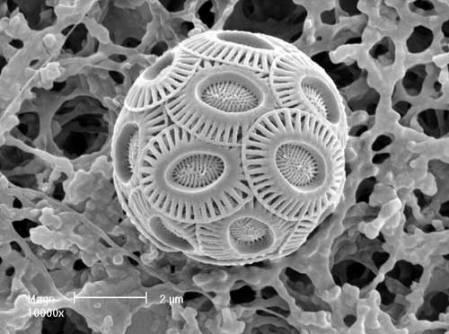Tom Richards from the Museum's Life Science department is an author on a paper in Nature that explores the genome of one of the most abundant species of planktonic plant - the coccolithophore Emiliania huxleyi. Coccolithophores occur in great numbers in the ocean: the chalk cliffs at Dover are made up of the remains of their calcium carbonate skeletons.
The World's oceans are tremendously complex. Currents move over thousands of kilometres, some descending as they are cooled by weather systems, or mixing at the surface with fresh waters, sediments and nutrients from continental rivers. Life is immensely diverse, ranging from corals to the deep-sea vent faunas. The highest biomass of life is in the shallow seas near to land, but the open ocean contains a constantly shifting system of tiny planktonic organisms ranging from bacteria to single-celled plants to grazing zooplankton and their predators.
These planktonic ecosystems change with currents, seasons, nutrient availability and predation. Their growth, population explosions, deaths and decline interact with the planet's cycling of carbon and other nutrients. These interactions are important in understanding ocean productivity and climate: there are links to carbon dioxide fluctuation, for example, as the plants absorb it during growth and release some at death. Despite the tiny size of the organisms, their huge numbers over two-thirds of the planet's surface means that their role in planetary systems is very significant.
E. huxleyi experiences huge population explosions in the open ocean - planktonic blooms. Some species of phytoplankton bloom under very particular conditions of temperature and nutrient availability, but E. huxleyi thrives in a wide range of conditions, occuring from the warm waters of the equator to polar regions.
 Emiliania huxleyi, showing the distinctive calcium carbonate plates that cover its exterior.
Emiliania huxleyi, showing the distinctive calcium carbonate plates that cover its exterior.
These may have important protective and light-reflecting qualities for the organism.
The paper finds that E. huxleyi strains from different areas share a core genome - this gives them a robust abilty to resist the inhibiting and damaging effects of intense sunlight, together with genes that allow effective growth in low phosphorus conditions. There are genetic differences between the strains that lead to distinct abilities to thrive in different nitrogen, ammonia and metal conditions. It seems that this, and other characteristics, give E. huxleyi the ability to bloom in very different oceanic environments - it is described as a species complex because of its genetic diversity.
This work will enable scientists to understand better the responses and influences of this very widespread species, and to investigate the complex processes and systems of the ocean that determine productivity and influence climate change.
Read, B.A. et al. (2013) Pan genome of the phytoplankton Emiliania underpins its global distribution. Nature doi:10.1038/nature12221


